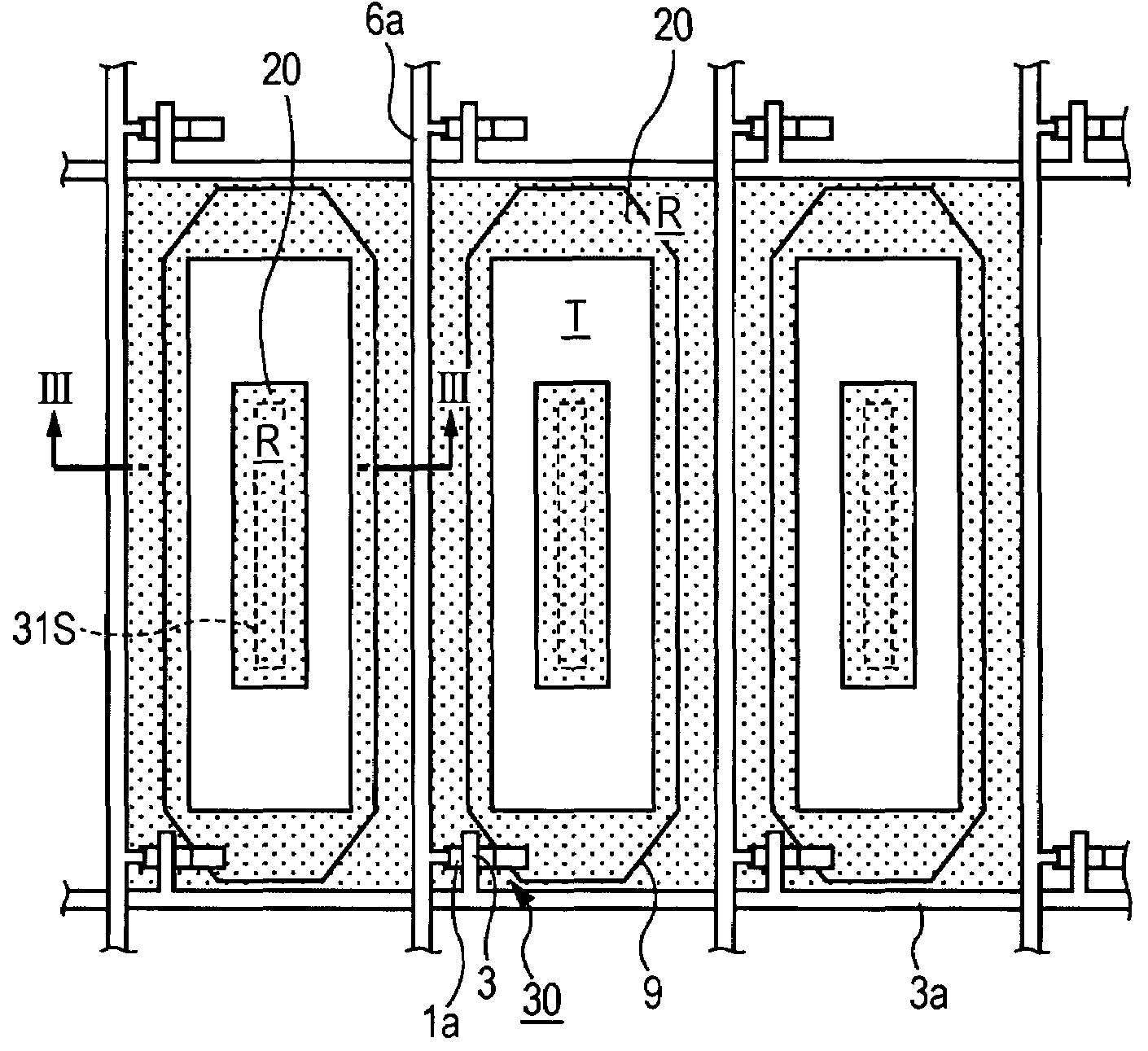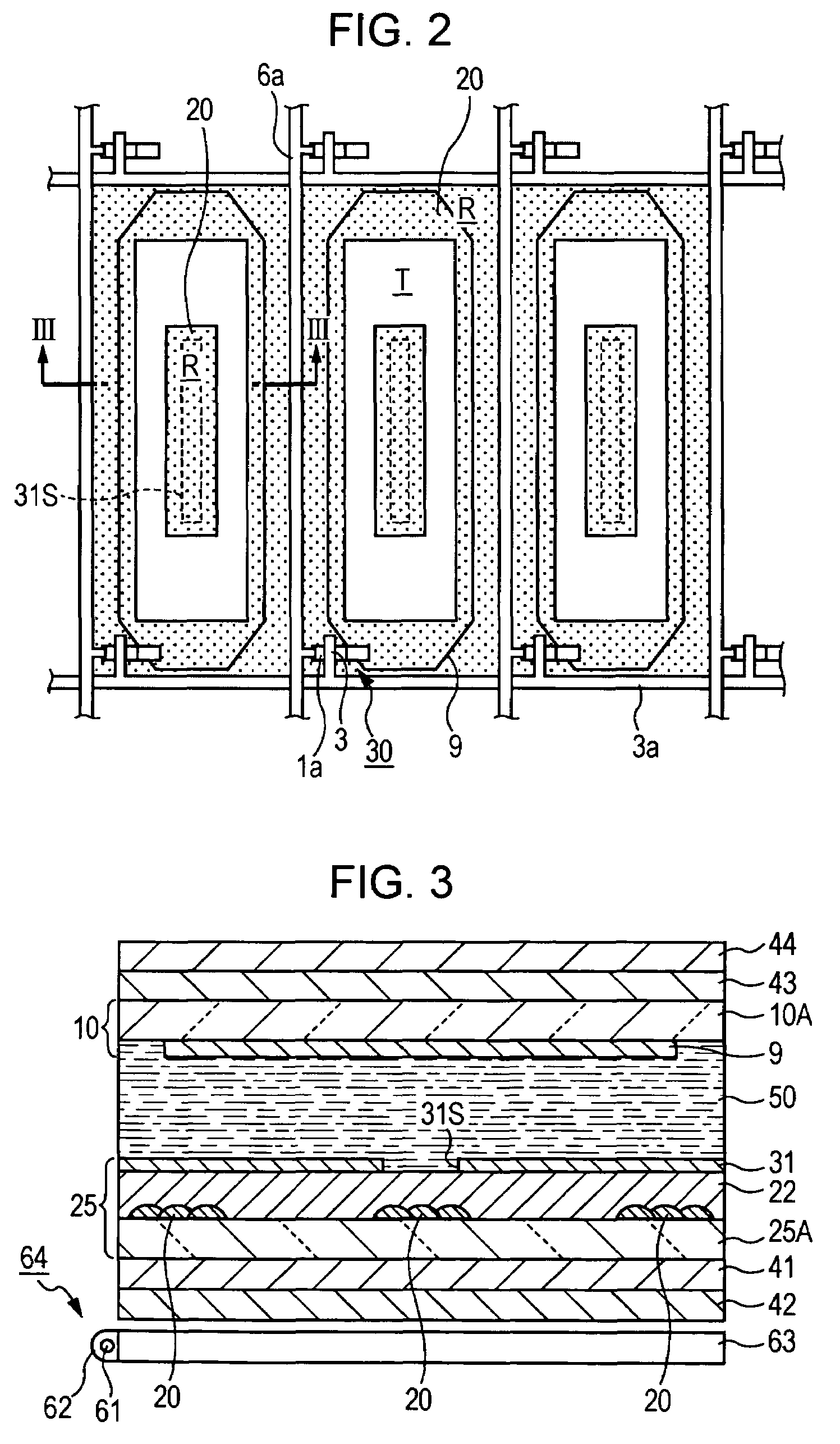Liquid crystal display device and electronic apparatus
a liquid crystal display device and electronic equipment technology, applied in non-linear optics, instruments, optics, etc., can solve the problems of difficult to form step differences, lack of freedom in optical design, and drawbacks of reflective liquid crystal display devices in the related art, so as to improve contrast, improve contrast, and improve contrast
- Summary
- Abstract
- Description
- Claims
- Application Information
AI Technical Summary
Benefits of technology
Problems solved by technology
Method used
Image
Examples
first embodiment
[0044]Hereinafter, a first embodiment of the invention will be described with reference to FIGS. 1 to 3.
[0045]A liquid crystal display device according to this embodiment is an example of an active-matrix-type liquid crystal display device using a thin film transistor (TFT) as a switching element.
[0046]FIG. 1 is an equivalent circuit diagram showing a plurality of dots, which are arranged in a matrix, constituting an image display region of the liquid crystal display device according the embodiment, FIG. 2 is a plan view showing a structure within a dot region of a TFT array substrate, FIG. 3 is a cross-sectional view, which is taken along line III-III of FIG. 2, showing a structure of the liquid crystal display device, and FIG. 4 is a view showing an alignment state of liquid crystal molecules. Throughout the drawings, the scale of each layer of member is adjusted in order to have a recognizable size in the drawings.
[0047]As shown in FIG. 1, for the liquid crystal display device ac...
second embodiment
[0064]Hereinafter, a second embodiment of the invention will be described with reference to FIGS. 5 and 6.
[0065]FIG. 5 is a cross-sectional view of a liquid crystal display device according to a second embodiment of the invention, and FIG. 6 is a view showing an alignment state of liquid crystal. The liquid crystal display device according to the embodiment has the same basic configuration as the first embodiment. Therefore, in FIGS. 5 and 6, the same elements as in FIGS. 3 and 4 are denoted by the same reference numerals and detailed explanation thereof will be omitted for the sake of simplicity.
[0066]In this embodiment, a convex portion 29 (alignment controller) having a triangular cross section is formed on the common electrode 31 located at the counter substrate 25 side, as shown in FIG. 5, instead of the opening 31S of the common electrode 31. The convex portion 29 is made of a dielectric material such as an acryl resin or the like and has a planar shape linearly formed in the ...
third embodiment
[0069]Hereinafter, a third embodiment of the invention will be described with reference to FIGS. 7 to 9.
[0070]FIG. 7 is a plan view showing configuration of dot regions of a liquid crystal display device according to the embodiment, FIG. 8 is a cross-sectional view taken along line VIII-VIII of FIG. 7, showing the configuration of the liquid crystal display device of the third embodiment, and FIG. 9 is a view showing an alignment state of liquid crystal when a selective voltage is applied. The liquid crystal display device according to the embodiment has the same basic configuration as the first embodiment. Therefore, in FIGS. 7 to 9, the same elements as in FIGS. 2 to 4 are denoted by the same reference numerals and detailed explanation thereof will be omitted for the sake of simplicity.
[0071]In the third embodiment, as shown in FIG. 7, the pixel electrode 9 is configured to include three island-shaped portions 9a, 9b, and 9c. The three island-shaped portions 9a, 9b, and 9c are ele...
PUM
| Property | Measurement | Unit |
|---|---|---|
| dielectric anisotropy | aaaaa | aaaaa |
| thickness | aaaaa | aaaaa |
| voltage | aaaaa | aaaaa |
Abstract
Description
Claims
Application Information
 Login to View More
Login to View More - R&D
- Intellectual Property
- Life Sciences
- Materials
- Tech Scout
- Unparalleled Data Quality
- Higher Quality Content
- 60% Fewer Hallucinations
Browse by: Latest US Patents, China's latest patents, Technical Efficacy Thesaurus, Application Domain, Technology Topic, Popular Technical Reports.
© 2025 PatSnap. All rights reserved.Legal|Privacy policy|Modern Slavery Act Transparency Statement|Sitemap|About US| Contact US: help@patsnap.com



